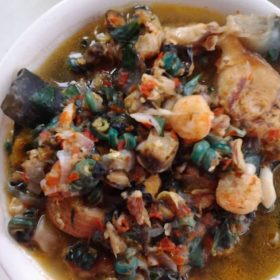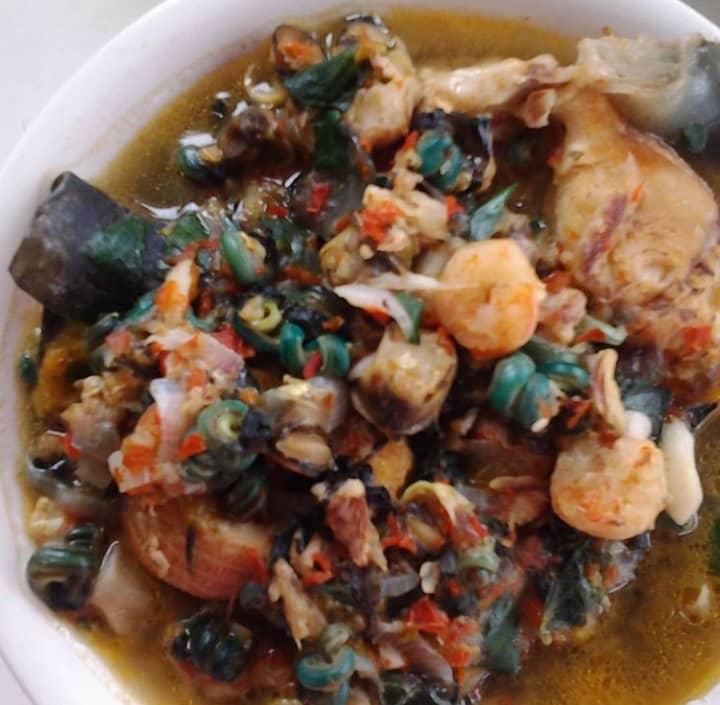Nigerian Food
How to Make ‘Port Harcourt’ Fisherman’s Soup (Rivers State Native Soup)
How to Make Fisherman’s Soup
Contents
As always, let’s start with a bit of history.
Nigeria is fortunate to be blessed with several water bodies, making fishing a dominant profession among the riverine communities within the country.
Fishing generally encourages migration because tidal movements greatly influence the availability of fish. This makes fishermen move to different settlements by the water current flow to increase their chances of catching fish. Since the migrations were unavoidable, the fishermen thought it wise to establish temporal fishing settlements where they could return to after they migrated to the water bodies around their temporal settlements.
Back in the day, only men were allowed to migrate for fishing purposes. So, when the time came for migration, their wives would gather and pack foodstuff to sustain their husbands until they returned. At the settlement, the fishermen made meals with anything their nets caught. It goes without argument that these fishermen invented this soup delicacy, born out of their passion for the river where they earned a living.
The fisherman’s soup is viral among the Niger-Delta states of Nigeria, mainly; in the riverine communities of Rivers, Akwa Ibom, Cross River, and Bayelsa. This delicacy gained popularity amongst the people of these communities because of the large body of water available in their communities. As a result, most people from these regions live from the sea; as fishermen.
Since the fisherman’s soup is prepared majorly with seafood, we will be discussing the health benefits of seafood.
Seafood is a high-protein food with low calories, total fat, and saturated fat. It is high in vitamins and minerals. Studies conducted on seafood have proven that it has a lot of health benefits. Health benefits include; the ability to decrease the risk of heart attack, both in early and late life, it aids in reducing the risk of stroke incidence, and a decrease in risk of obesity and hypertension.
Again, seafood, mainly fish, contains omega-three fatty acids, which contribute to the neurological development of infants.
It also contributes to vision development and nerve growth in the retina of the eyes. A 2014 study published in the Investigative Ophthalmology and Visual Science journal suggests that those who consume the Omega-3 fatty acids in seafood are less likely to suffer from age-related macular degeneration. This disease can result in the loss of vision. Fish and shellfish can help enhance your night vision. Since seafood is rich in proteins, they help build up muscles and tissues.
There are different recipes for making this soup, exclusive to different communities within the Niger Delta. While some people use Tomatoes in preparing this food, others do not. Some people use Okro while others do not. Again, some people decide to use Garri in thickening the soup, while others use pounded yam or cocoyam. The different styles for cooking this meal only show creativity in cooking and don’t show that one way is better than the other. However, the recipe I will be using is the most common among the people of Rivers State.
Well, I must say that I am sentimental about my choice of recipe, mostly because I grew up in the city of Port Harcourt and have always enjoyed this meal at home and whenever I visit my Ikwerre friends.
This soup doesn’t take a long time to prepare at all. This is because seafood generally gets cooked within minutes. Remember that this soup is best enjoyed when it is spicy and steamy hot. This soup can be enjoyed with Pounded Yam, Eba, Semo, or Fufu.

How to Make Fisherman’s Soup
The fisherman’s soup is very popular among the Niger-Delta states of Nigeria, mainly; the riverine communities of Rivers, Akwa Ibom, Cross River and Bayelsa.
Ingredients
- 2 pcs Fresh Fish (You can use tilapia)
- 1 Cup Chopped Jumbo Shrimps
- 1 Cup Isam (Periwinkle)
- 4 Pcs Crab
- 1.5 Cup Fresh Crayfish (Chopped)
- 1.5 Cup Chopped Uziza Leaf
- 1 Small Bulb of Onion
- 1 Cup Ngolo
- 2 tbsp Cocoyam Paste for thickening
- 2 cubes Seasoning (Knorr/Maggi) ...to taste
- 1 tbsp Powdered Crayfish
- 1 tbsp Palm Oil
- 1 tbsp Dry Pepper
- 1 pc Scotch Bonnet Pepper
- 2 tbsp Salt ...to taste
Instructions
In a clean pot of boiling water, place your Cocoyam. Cook until it is soft. Once soft, peel it and pound till it is completely smooth, forming a paste.
Add all the seafood apart from the fresh pieces of crayfish in a separate pot. Season with the scotch bonnet pepper, onion, dry pepper, seasoning cubes, and salt. Allow the seafood to boil and cook properly in 1-2 cups of water.
Once the sea foods are cooked, add the fresh pieces of crayfish and the crayfish powder. Allow to simmer for 1 minute.
Add the cocoyam paste, and stir appropriately until the cocoyam has dissolved completely and is evenly distributed. Add your palm oil and Uziza and allow to simmer for a minute.
YourRivers State fisherman’s soup is ready. You can serve with Garri, Pounded yam or any swallow of your choice.
What is “Ngolo”?
‘Ngolo’ in South-South Nigeria, also known as Whelks, are marine snails – also known as gastropods or edible mollusks. In the United States, they are more commonly known as scungilli. Source: @ruttsocean


This is lots better than the other recipes and method .thank you
Thank you for your feedback. I’m glad it was helpful.
Thank you… please what is Ngolo?
Snails
The best recipe so far.
Thank you sooo much for the recipe
A relaxing meal when taken.
What’s Ngolo?
Thanks, I must confess, this is the best recipe so far. Can u pleased tell us another name for Ngolo?
Whelks, known as ‘Ngolo’ in South-South Nigeria, are marine snails – they are also known as gastropods, or edible mollusks. In the United States, they are more commonly known as scungilli. Source: @ruttsocean
Wonderful recipe. Kudoz
Very easy..
Can’t wait to prepare this soup..
Can I use Achi (thickener in place of coco yam)
Please how do you prepare the one they use to add okro
Thanks for this
Thanks for the details.
If I don’t add crabs, will I still get it right?
Ngolo is the rivers and bayelsa name
Nkornkor is what akwa ibom and cross river people call it.
What about okro
Is okro not part of it
I think okra is optional. If in calgary I sell this on Kjiji and doordash just type Enchanting Eats. Best all
Thank you for sharing the recipe i will try and prepare it